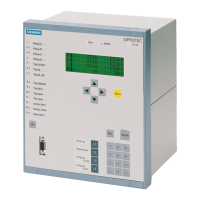2 Functions
280
7SD5 Manual
C53000-G1176-C169-1
Add (address 2656 for earth currents) are in addition to the time delays resulting from
the set curves.
The parameter I(3I0)p Tele/BI (address 2670) defines whether the time delays
Time Dial TD Ip (address 2643), including the additional delay T Ip Add (ad-
dress 2646), and TimeDial TD3I0p (address 2653), including the additional delay
T 3I0p Add (address 2656), can be bypassed by the binary input „>O/C
InstTRIP“ (No. 7110). The binary input (if allocated) is applied to all stages of the
time-overcurrent protection. With I(3I0)p Tele/BI = YES you define that the IP
stages trip without delay after pickup if the binary input was activated. For I(3I0)p
Tele/BI = NO the set delays are always active.
Instantaneous tripping by the operational auto-reclosure function should only be
chosen if the overcurrent protection is set to emergency function
. Since the fast main
protection function - differential protection and/or distance protection - guarantees a
fast and selective tripping with or without auto-reclosure, the overcurrent protection as
a back-up protection
may not perform a non-selective trip, even before auto-reclosure.
If the IP stage, when switching the line on to a fault, is to trip without delay or with a
short delay, SOTF Time DELAY (address 2680, see above under margin heading
„General“), the parameter I(3I0)p SOTF (address 2671) is set to YES. We recom-
mend, however, not to choose the sensitive setting for the switch on to a fault function
as energizing of the line on to a fault should cause a large fault current. It is important
to avoid that the selected stage picks up due to transients during line energization.
Additional Stage
I
ph
>>>
The I-STUB stage can be used as an additional definite time overcurrent stage, since
it works independently of the other stages. In this case, the enable input „>I-STUB
ENABLE“ (No 7131) must be activated permanently (via a binary input or CFC).
Since the I-STUB stage has an additional enable input, it is also suitable e.g. as an
emergency stage if the remaining stages are used as backup stages. The release
input „>I-STUB ENABLE“ (No. 7131) can be assigned the output signal „Emer.
mode“ (No. 2054) (either via binary outputs and inputs or via the user-definable logic
CFC functions).
The considerations for the use of the I-STUB stage as an emergency function are the
same as for the I> stages. The setting value Iph> STUB (address 2630) must here
too be higher than the maximum operational current to be expected, in order to avoid
pickup without fault. The delay T Iph STUB (address 2631), however, can be shorter
than defined in the time grading schedule, since this stage works only in emergency
operation, i.e. in case of a communication failure of the differential protection or a local
measurement voltage failure of the distance protection. Normally, one grading time
above the base time of the differential protection is sufficient.
The residual current stage 3I0> STUB (address 2632) should correspondingly pick
up on the smallest residual current to be expected during an earth fault and the delay
T 3I0 STUB (address 2633) should exceed the base time of the differential protec-
tion by one grading time. If only the phase currents are to be monitored, set the pickup
value of the residual current stage to ∞.
The I-STUB stage can also be accelerated by the enable signal „>O/C InstTRIP“
(No 7110), e.g. before an auto-reclosure. This is defined with parameter I-STUB
Telep/BI (address 2634). Set it to YES if the ISTUB stage is to trip without delay as
long as the binary input „>O/C InstTRIP“ is activated or the internal auto-reclosure
function is ready to operate. Instantaneous tripping by the operational auto-reclosure
should only be chosen if the I-STUB stage is set as an emergency function. If the main
protection function - differential and/or distance protection - are out of operation, this
emergency stage guarantees instantaneous tripping before auto-reclosure.
www . ElectricalPartManuals . com
